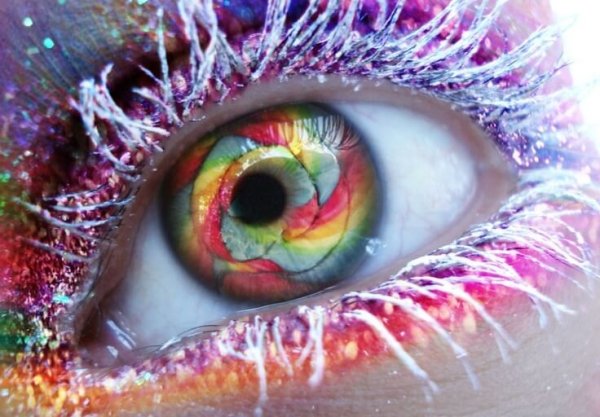Life Changes When You Change a Thought

Each new thought is like a little lightning strike in our brain. Nobody has ever seen thoughts, but their power is infinite: they shape the way we see the world and they encourage us with rejuvenating emotions so that we can transform our reality.
Today there is an abundance, almost an excess, of books that invite us to increase the power of our mind or to “become more intelligent” following a somewhat esoteric and unscientific line of thought. Perhaps those authors have forgotten that neuroscience already offers us marvelous answers and new perspectives to understand the mechanisms that govern our brain much better.
“Reality is just a perception, albeit a very persistent one”
-Albert Einstein-
Terms like neurogenesis and neuroplasticity have enabled great progress in comparison to when it was thought that the adult mind stopped generating new nerve cells at a certain age. Our thoughts are an unquestionably powerful weapon, because they create new bridges, new connections that re-orientate the map of our emotions or the projector strip that sets in motion the movie of our lives…

The thoughts that create your reality
Thanks to the continual development of diagnostic techniques like computerized tomography, great progress has been achieved in terms of understanding brain function. One of the most interesting discoveries has been that of finally understanding how thoughts are created. Let’s take an example: when we watch a red ball and our retina captures each characteristic, the information travels through structures like the geniculate nucleus and the prestriate cortex, etc.
“We are all born original and we end up as copies.”
However, if we close our eyes and someone tells us to think about a red ball, surprising as it may seem, our brain will activate exactly the same structures. That is to say, the brain reflects the same activity when it sees as when it feels. This surprising information forces the whole scientific community and all of us to ask ourselves the same question: if for the brain there is no difference between what it sees and what it imagines… what is our authentic reality?
Without a doubt, here the whole conceptual area of the quantum mind comes into play, but we’re going to leave this out for now and stick to more useful, concrete aspects. Our reality consists of something as simple as it is powerful: our emotions, where our thoughts are the true catalysts. To understand this better, we’re going to go deeper into a series of basic aspects.

What are thoughts?
A thought is simply a certain chemical formula accompanied by an electrical impulse. This may seem sad, but at the same time it is fascinating. Each time we think something, our nerve cells connect through the synaptic fissures discharging a certain type of biochemical.
We know that our thoughts generate our emotions. When they send a message, it is our hippocampus that is responsible for translating the message by discharging a series of neuropeptides through the pituitary gland. These neuropeptides are then released into the blood, triggering a series of reactions.
Little by little, the following can happen: if our brain gets used to receiving a certain pattern of emotions, it can end up creating habitual thoughts. This is what happens for example with stress: sometimes, we become so overtaken by a certain emotion (fear) that we lose control, moving forward day by day in a reality that we don’t identify with.
What kind of reality do you prefer?
This is not about being “more intelligent” or aspiring to increase your IQ overnight. Rather, it is simply about being capable of creating a reality that matches our needs, our own characteristics and our total right to be happier.
“Reality is always there, what matters is your perception”
-Diego Dillenberg-
To achieve this, we should first become aware of one thing: our reality is biased by our state of mind, the weight of our memories, our interpretations and thoughts. There will always be some people who walk through life with tunnel vision, in a reality so closed that they are incapable of seeing all the possibilities around them.
Let’s learn to see the world in panorama and technicolor vision, let’s create a broader reality. Here’s how:

Our thoughts and neurogenesis
Neurogenesis refers to our natural ability to generate new nerve cells. While in 1928, Santiago Ramón y Cajal stated that “everything can die, nothing can regenerate”, today this statement collapses if we consider our mind, the fabulous architect of our reality.
- Firstly, it is important to remember that the greatest enemy of our mind is stress. So much so that it changes its inner structure, reduces neuronal connectivity and even reduces the size of the hippocampus.
- We need to manage our emotional world and remember that it is our thoughts that govern it. One way of achieving this is using the following questions: How do I want to feel? How do I feel now? What worries me? What can I do to resolve this?
- A firm, brave and optimistic internal dialogue can help us to channel many of our negative emotions.
- Remember too that physical exercise is a wonderful way of promoting neurogenesis. Not only does it oxygenate the brain, but it also relieves stress thanks to the endorphins it releases and it generates new nerve cells.
- Another way of generating new thoughts is through changing habits. Breaking routines, putting ourselves into new situations, practicing new hobbies or meeting stimulating people is very restorative for our brain and our state of mind.
Lastly, we cannot forget the wonderful effects of meditation for our mind. This practice that harmonizes mind and body has great effects on our emotional world, promoting Alpha and Gamma waves, which create greater neuronal connectivity.
Let’s be architects of our reality. Let’s remember that there is no such thing is neutral thoughts, all thoughts are capable of creating a certain reality. It’s up to us to make it marvelous.
Each new thought is like a little lightning strike in our brain. Nobody has ever seen thoughts, but their power is infinite: they shape the way we see the world and they encourage us with rejuvenating emotions so that we can transform our reality.
Today there is an abundance, almost an excess, of books that invite us to increase the power of our mind or to “become more intelligent” following a somewhat esoteric and unscientific line of thought. Perhaps those authors have forgotten that neuroscience already offers us marvelous answers and new perspectives to understand the mechanisms that govern our brain much better.
“Reality is just a perception, albeit a very persistent one”
-Albert Einstein-
Terms like neurogenesis and neuroplasticity have enabled great progress in comparison to when it was thought that the adult mind stopped generating new nerve cells at a certain age. Our thoughts are an unquestionably powerful weapon, because they create new bridges, new connections that re-orientate the map of our emotions or the projector strip that sets in motion the movie of our lives…

The thoughts that create your reality
Thanks to the continual development of diagnostic techniques like computerized tomography, great progress has been achieved in terms of understanding brain function. One of the most interesting discoveries has been that of finally understanding how thoughts are created. Let’s take an example: when we watch a red ball and our retina captures each characteristic, the information travels through structures like the geniculate nucleus and the prestriate cortex, etc.
“We are all born original and we end up as copies.”
However, if we close our eyes and someone tells us to think about a red ball, surprising as it may seem, our brain will activate exactly the same structures. That is to say, the brain reflects the same activity when it sees as when it feels. This surprising information forces the whole scientific community and all of us to ask ourselves the same question: if for the brain there is no difference between what it sees and what it imagines… what is our authentic reality?
Without a doubt, here the whole conceptual area of the quantum mind comes into play, but we’re going to leave this out for now and stick to more useful, concrete aspects. Our reality consists of something as simple as it is powerful: our emotions, where our thoughts are the true catalysts. To understand this better, we’re going to go deeper into a series of basic aspects.

What are thoughts?
A thought is simply a certain chemical formula accompanied by an electrical impulse. This may seem sad, but at the same time it is fascinating. Each time we think something, our nerve cells connect through the synaptic fissures discharging a certain type of biochemical.
We know that our thoughts generate our emotions. When they send a message, it is our hippocampus that is responsible for translating the message by discharging a series of neuropeptides through the pituitary gland. These neuropeptides are then released into the blood, triggering a series of reactions.
Little by little, the following can happen: if our brain gets used to receiving a certain pattern of emotions, it can end up creating habitual thoughts. This is what happens for example with stress: sometimes, we become so overtaken by a certain emotion (fear) that we lose control, moving forward day by day in a reality that we don’t identify with.
What kind of reality do you prefer?
This is not about being “more intelligent” or aspiring to increase your IQ overnight. Rather, it is simply about being capable of creating a reality that matches our needs, our own characteristics and our total right to be happier.
“Reality is always there, what matters is your perception”
-Diego Dillenberg-
To achieve this, we should first become aware of one thing: our reality is biased by our state of mind, the weight of our memories, our interpretations and thoughts. There will always be some people who walk through life with tunnel vision, in a reality so closed that they are incapable of seeing all the possibilities around them.
Let’s learn to see the world in panorama and technicolor vision, let’s create a broader reality. Here’s how:

Our thoughts and neurogenesis
Neurogenesis refers to our natural ability to generate new nerve cells. While in 1928, Santiago Ramón y Cajal stated that “everything can die, nothing can regenerate”, today this statement collapses if we consider our mind, the fabulous architect of our reality.
- Firstly, it is important to remember that the greatest enemy of our mind is stress. So much so that it changes its inner structure, reduces neuronal connectivity and even reduces the size of the hippocampus.
- We need to manage our emotional world and remember that it is our thoughts that govern it. One way of achieving this is using the following questions: How do I want to feel? How do I feel now? What worries me? What can I do to resolve this?
- A firm, brave and optimistic internal dialogue can help us to channel many of our negative emotions.
- Remember too that physical exercise is a wonderful way of promoting neurogenesis. Not only does it oxygenate the brain, but it also relieves stress thanks to the endorphins it releases and it generates new nerve cells.
- Another way of generating new thoughts is through changing habits. Breaking routines, putting ourselves into new situations, practicing new hobbies or meeting stimulating people is very restorative for our brain and our state of mind.
Lastly, we cannot forget the wonderful effects of meditation for our mind. This practice that harmonizes mind and body has great effects on our emotional world, promoting Alpha and Gamma waves, which create greater neuronal connectivity.
Let’s be architects of our reality. Let’s remember that there is no such thing is neutral thoughts, all thoughts are capable of creating a certain reality. It’s up to us to make it marvelous.
This text is provided for informational purposes only and does not replace consultation with a professional. If in doubt, consult your specialist.







